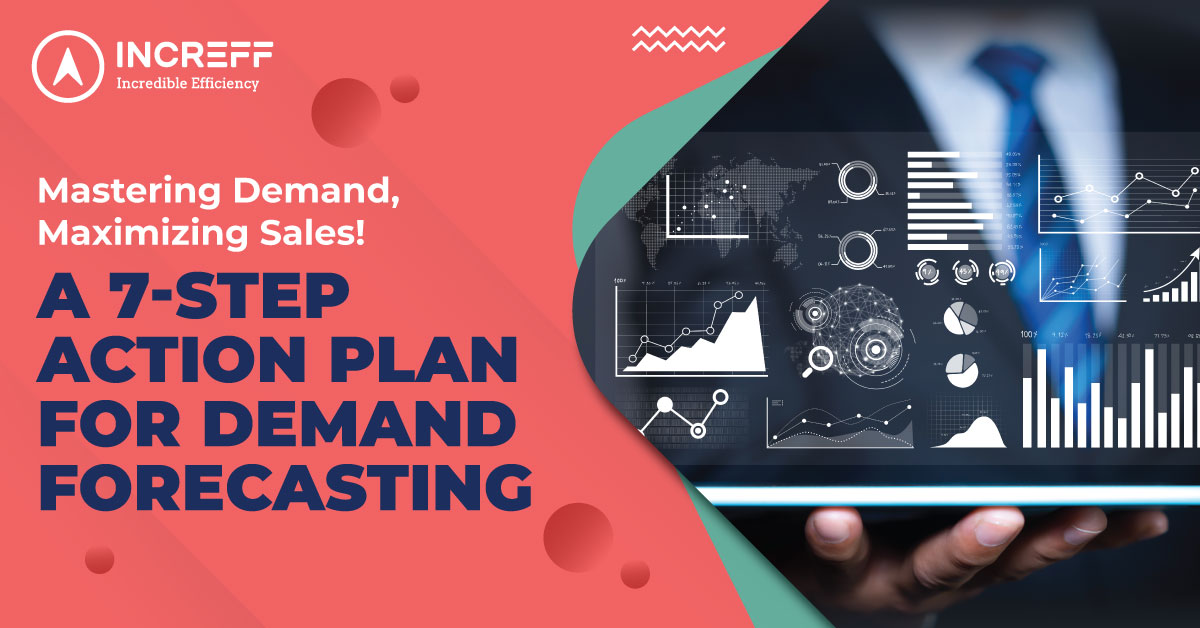
SSmart Merchandising
Mastering Demand Forecasting: A Comprehensive 7-Step Roadmap to Maximize Sales
Amazon, the massive online retailer, rakes in significant profits in North America because numerous local stores struggle to accurately predict how much of a product people want to buy. So, when eager customers head to their nearby stores to purchase something they truly desire, they are often met with disappointment as the item is out of stock. Frustrated and impatient, these shoppers turn to the ever-reliable Amazon, which appears to possess a remarkable knack for promptly meeting their demands.
This anecdote underscores a fundamental truth in the retail world: accurate demand forecasting is not just about predicting how many units of a product you’ll sell. It’s a strategic imperative that can determine the fate of businesses. Beyond bolstering sales, effective demand forecasting is a linchpin for managing cash flow and maintaining streamlined operations. If you’re caught with excess inventory or can’t keep up with customer demand, you’re essentially bleeding money.
In this blog, we embark on a journey through a seven-step action plan tailored for retail merchandisers to revolutionize demand forecast accuracy. By implementing these steps, retailers can drive significant sales growth while ensuring financial prudence and operational efficiency. Let’s explore how these strategies can transform your retail business into a well-oiled, demand-forecasting machine.
Step 1: Understanding Your Customers
A solid demand forecasting strategy hinges on a thorough grasp of your customer base. This entails the meticulous collection and analysis of data related to customer preferences, purchasing behaviors, and historical buying trends. To delve deeper into your customer base, it is advisable to establish direct communication channels with them. In the context of B2B operations, supplier portals and data exchanges can prove to be invaluable resources for forecasting customer demand accurately.
Conversely, in the realm of B2C enterprises, harnessing real-time localized consumer data serves as the cornerstone for crafting a comprehensive demand forecast that can form the basis for a unified demand forecast shared with stakeholders. This multifaceted process involves the implementation of surveys, careful scrutiny of customer feedback, and segmentation of customers based on various factors such as demographics and buying habits, all of which yield invaluable insights.
To gain a comprehensive understanding of your customers, it is advisable to explore questions such as:
- Do my customers exhibit seasonal shopping patterns, or do they maintain a consistent buying pattern throughout the year?
- What are the preferred sizes and colors among my customers?
- Are there particular brands that hold a special appeal to my customer base?
- What are the unique preferences of shoppers in my local area?
- How swiftly do consumer trends catch on with shoppers in the vicinity of my store?
This in-depth comprehension of your customer base forms the foundation upon which you can tailor your forecasts to precisely match the unique needs and preferences of your customers.
Step 2: Leverage Technology and Automation to Increase Accuracy
In the realm of retail, a notable portion of industry participants continues to rely on antiquated planning systems and labor-intensive methodologies for gauging customer preferences. In times past, these conventional approaches sufficed due to a relatively stable market landscape. However, in today’s dynamic and ever-evolving market environment, the imperative for change is unmistakable.
A noteworthy issue lies in the fact that approximately 15% of inventory inaccuracies can be attributed to software systems that lack interoperability, thereby fostering communication impediments. Moreover, when we disregard the integration of technology, we expose ourselves to data inconsistencies that arise from human errors.
Embracing advanced technologies and automation tools can significantly enhance demand forecast accuracy. Algorithms, artificial intelligence, and predictive analytics can process vast amounts of data quickly and provide more accurate predictions.
For retailers looking to secure a competitive edge, investment in cutting-edge forecasting and adaptable tools, capable of learning from evolving market patterns, is imperative. By doing so, these businesses can not only rectify inventory inaccuracies but also empower their teams to concentrate on more strategic, high-value tasks, thereby ensuring the continued prosperity of their operations.
Step 3: Centralize Your Data for Real-Time Visibility
To improve forecast accuracy, retailers should centralize their data sources and create a single source of truth. A centralized data repository enables real-time visibility into inventory levels, sales data, and other relevant information. This centralized approach allows for quick decision-making and ensures that all stakeholders are working with the same data.
Step 4: Don’t Let Go of Past Data
Historical data represents an invaluable asset in the quest for more accurate demand forecasting. Retailers should maintain a comprehensive historical dataset that includes records of sales, revenue, discount strategies, promotional activities, size-related variations, stockouts, and exposure metrics. This historical data provides a solid foundation for forecasting, as it sheds light on past patterns and trends, which are essential for shaping future forecasts.
Furthermore, a thorough analysis of historical data can uncover valuable insights for optimizing the assortment mix and depth. By examining this data, retailers gain a holistic perspective that helps in fine-tuning inventory strategies. This comprehensive approach also simplifies the identification and rectification of issues, such as size cuts and highly discounted sales within the sales history. All of these factors contribute to a more refined and accurate forecasting process.
Step 5: Bring in In-Depth Algorithm Analysis
In-depth algorithm analysis is crucial for retailers to enhance demand forecasting. This involves ongoing assessment to understand model strengths and weaknesses, ensuring adaptability to shifting market dynamics. Steps include identifying persistent top sellers, conducting granular-level computations with multiple product attributes, and analyzing past data to determine the ideal assortment mix and depth. By focusing on these aspects, retailers can fine-tune their forecasting algorithms, leading to more accurate predictions and improved inventory management.
Step 6: Incorporate Granularity Models
One-size-fits-all forecasting models may not provide the level of accuracy needed in today’s retail landscape. To improve accuracy, consider incorporating granularity into your forecasting models. Granularity here entails crafting distinct forecasts for various product categories, individual store locations, and even delving into the realm of SKU-level forecasts. This meticulous level of detail empowers retailers to make more pinpoint predictions and execute inventory optimization strategies with greater finesse.
This approach is not just about accuracy; it’s also about understanding the intricate nuances of your inventory. It enables retailers to predict true size ratios more effectively, ensuring that stock levels align with customer demands. Additionally, incorporating planned trends and promotions through a granular override system further refines forecasting accuracy. By dissecting and addressing each component of your retail operations with granularity, you’re better equipped to navigate the complexities of the modern retail environment, ultimately driving growth and profitability.
Step 7: Remember External Factors Do Matter
Recognizing that demand forecasting extends beyond historical data, it’s crucial to understand the significant influence of external factors. Economic conditions, weather patterns, seasonality, and market trends all play pivotal roles in shaping consumer behavior. As we touched upon when discussing causal relationships in forecasting demand, the integration of these external factors is paramount.
Let’s emphasize this point for its critical importance: always consider external factors. While you may have a solid grasp of your marketing strategies, promotional schedules, and the predictable holiday selling seasons, the realm of unpredictable and uncontrollable variables remains. These external factors can introduce unforeseen changes and disruptions that must be accounted for within your forecasting models to ensure accuracy.
Over to you
Have you started basic forecasting for your retail business? Implementing these strategies can put retailers’ guesswork to rest and make them better at understanding what their customers will buy, all based on data analysis. It’s like having a predictive tool that helps them stock the right items at the right times. When they do this, it makes everything in their supply chain work more smoothly, like a well-oiled machine.
What’s even more critical is that it ensures customers are more likely to find what they want when they come to the store, which makes them really happy. And as we know, happy customers are more likely to return and buy more, creating a win-win situation for everyone involved!
If this is something you are interested in, we can help you with it. Just get in touch with our experts today.
25 September, 2023
RRegional Utilization
Riding the E-commerce Wave: Prepping for Peak Season…
The holiday season is the busiest time of the year for e-commerce brands. With the…
30 October, 2023
6 months agoSSmart Merchandising
Top 5 Merchandising Solutions: Global Leaders in Enabling…
Have you ever considered the intricacies of managing a fashion brand across both retail and…
5 September, 2023
8 months agoSSmart Merchandising
How to sell effectively on online marketplaces?
Success in the fast-paced world of diverse marketplaces hinges on selling efficiently. As an e-commerce…
3 July, 2023
10 months ago



